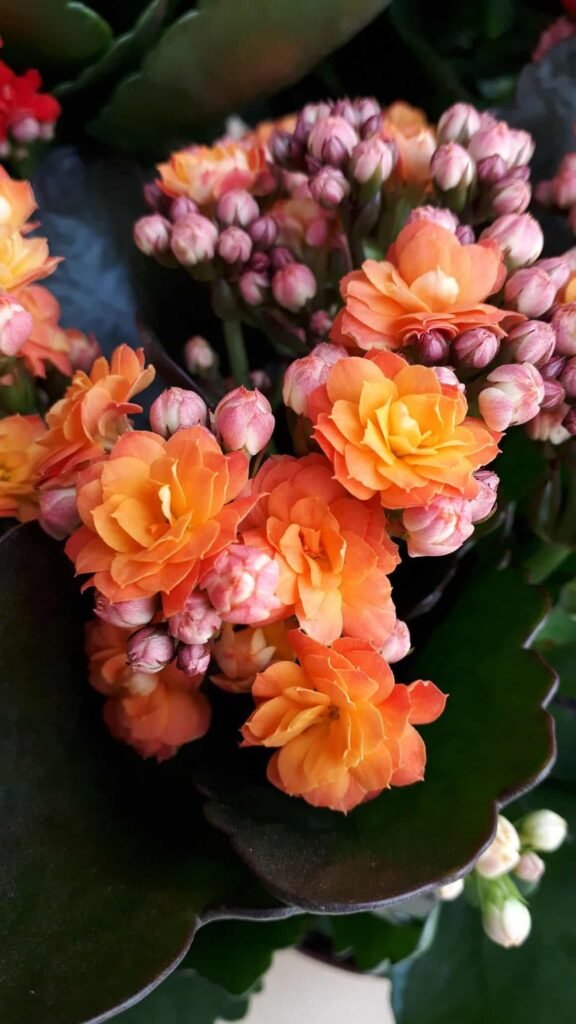The Calandiva plant is a stunning succulent known for its clusters of small, rose-like flowers that bloom in a variety of colors such as pink, red, orange, and white. This plant is a hybrid of the popular Kalanchoe blossfeldiana and is often kept indoors as a decorative houseplant. The best part? Calandiva plants are low-maintenance, making them perfect for beginners.
In this detailed guide, we’ll cover everything you need to know about Calandiva plant care, from light and water needs to soil, temperature, and common problems.

Table of Contents
🌞 Light Requirements for Calandiva Plant
The Calandiva loves bright, indirect sunlight. Place it near a south- or west-facing window where it gets plenty of light but is not exposed to harsh midday sun.
- If grown outdoors, choose a spot with partial shade.
- If grown indoors, rotate the pot occasionally to ensure even growth.
- Without enough light, the plant may become leggy and produce fewer flowers.
💧 Watering the Calandiva Plant
Like most succulents, the Calandiva does not like too much water. Overwatering is the most common mistake new plant parents make.
- Water only when the top 1–2 inches of soil feels dry.
- During the growing season (spring and summer), water once every 7–10 days.
- In winter, reduce watering to once every 2–3 weeks.
- Always use a pot with drainage holes to prevent root rot.
💡 Tip: Water less during the plant’s resting period after flowering.
🌱 Best Soil for Calandiva Plant
The Calandiva thrives in well-draining soil. Since it is a succulent, it prefers soil that does not hold excess water.
- A good mix: 2 parts cactus soil + 1 part perlite or sand.
- Avoid heavy, clay-based soils that retain moisture.
- Repot the plant every 2–3 years to refresh the soil and give the roots more space.
🌡️ Temperature and Humidity Needs
Calandiva plants prefer warm, dry conditions.
- Ideal temperature: 60°F–85°F (16°C–29°C).
- Protect the plant from frost — it cannot survive cold drafts.
- Average room humidity is enough; avoid very humid places.
If you live in a colder climate, bring your Calandiva indoors during the winter months.
🌸 Fertilizer and Flowering Tips
One of the best features of Calandiva is its long bloom period. With the right care, the flowers can last up to 6 weeks!
- Fertilize once a month during the growing season with a balanced liquid fertilizer (10-10-10 or 20-20-20).
- Reduce fertilizing in the winter.
- After flowering, trim off dead blooms to encourage new buds.
💡 Fun fact: Calandiva plants are “short-day plants,” meaning they bloom best when the days are shorter. To encourage flowers, keep the plant in darkness for 12–14 hours a day for about 6 weeks.
✂️ Pruning and Maintenance
Regular pruning keeps your Calandiva neat and healthy.
- Remove faded flowers and yellow leaves.
- Trim leggy stems to promote bushier growth.
- Wipe the leaves with a damp cloth to remove dust.
⚠️ Common Problems and Solutions
- Yellow Leaves → Usually caused by overwatering. Reduce watering and check soil drainage.
- Leggy Growth → Plant is not getting enough sunlight. Move it to a brighter location.
- No Flowers → Lack of light or not enough rest period. Give the plant some dark hours to trigger blooming.
- Pests → Calandiva can sometimes attract aphids or mealybugs. Use neem oil spray or insecticidal soap to remove them.
🌿 Calandiva Plant Benefits
- Air-purifying: Like many succulents, it helps clean indoor air.
- Low-maintenance: Perfect for busy plant lovers.
- Decorative: Its long-lasting flowers brighten up any room.
- Gift plant: Symbolizes endurance and beauty, making it a thoughtful present.
Final Thoughts 🌸
The Calandiva plant is a hardy, low-maintenance succulent that rewards you with beautiful, rose-like flowers that last for weeks. With the right mix of sunlight, water, and soil, this plant can thrive indoors and outdoors.
Whether you are a beginner gardener or a plant enthusiast, the Calandiva will add a pop of color and joy to your home. Just remember: don’t overwater, give it enough light, and enjoy its stunning blooms.

It’s too good, it has solved my problems about caring my plant